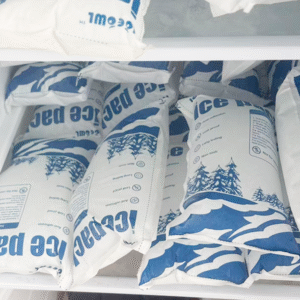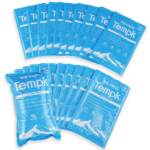How Do Dry Ice Shipping Bags and Pack Sheets Ensure Safe Meat Transportation?
When it comes to shipping temperature-sensitive goods such as meat, maintaining the required freezing or chilling temperatures is crucial. Trockeneis-Versandtaschen and pack sheets are essential tools in the cold chain logistics process, ensuring that meat products stay frozen and safe during transit. These solutions not only help preserve product quality but also provide businesses with cost-effective, reliable shipping methods. In diesem Artikel, we will delve into how dry ice shipping bags and pack sheets work, their benefits for meat transportation, and how to implement them effectively in cold chain logistics.

-
What are dry ice shipping bags and dry ice pack sheets, Und wie funktionieren sie??
-
How do these tools help maintain the right temperature for meat products?
-
What are the benefits of using dry ice in meat transportation?
-
How can businesses implement dry ice solutions in their cold chain logistics?
What Are Dry Ice Shipping Bags and Dry Ice Pack Sheets?
Dry ice shipping bags and dry ice pack sheets are innovative cold chain packaging materials designed to keep temperature-sensitive goods, wie Fleisch, at the correct temperature during shipping. Trockeneis, Das ist festes Kohlendioxid, sublimes (transforms directly from a solid to a gas), absorbing heat and providing a cooling effect.
-
Trockeneisschifffahrtsbeutel: These are typically made from durable, insulated materials that enclose dry ice, providing a secure and efficient way to keep meat products frozen during transport.
-
Trockeneisbeutelblätter: These are flexible sheets of dry ice that can be placed directly on or around meat shipments, offering uniform temperature control throughout the transport process.
By using these packaging solutions, businesses can ensure that products like beef, Geflügel, or seafood remain safe and fresh throughout their journey.
How Do Dry Ice Shipping Bags and Pack Sheets Work?
The process is simple yet highly effective. Dry ice sublimates during transit, Wärme aus der Umgebung aufnehmen, which prevents the meat from warming up. This method is particularly beneficial for meat products that require temperatures well below freezing.
Trockeneisschifffahrtsbeutel:
These bags enclose dry ice in insulated packaging, helping to maintain frozen temperatures for up to 48 Std., depending on the quantity of dry ice used. They are perfect for long-distance shipping and ensure that meat products stay frozen during extended transit times.
Trockeneisbeutelblätter:
Diese dünn, flexible sheets are an efficient way to keep the temperature consistent. Placing the sheets directly on the meat or lining the shipping box ensures that the cold air is evenly distributed, reducing the risk of warm spots that could cause spoilage.
By calculating the right amount of dry ice and ensuring proper insulation, businesses can reliably transport frozen meat products across long distances while maintaining their quality.
| Temperaturkontrollmethode | Zeitrahmen | Wirksamkeit | Praktische Anwendung |
|---|---|---|---|
| Trockeneisbeutel | 24–48 Stunden | Hochwirksam | Ideal for shipping frozen meat across long distances |
| Trockeneisbeutelblätter | 12–24 Stunden | Mäßig | Suitable for smaller shipments or shorter travel times |
| Gelpackungen | 12–24 Stunden | Mäßig | Best for less temperature-sensitive meat products |
How Do Dry Ice Shipping Bags and Pack Sheets Maintain the Right Temperature for Meat Products?
Dry ice functions by absorbing heat from its surroundings as it sublimates, creating a cold environment inside the shipping container. This cooling effect is critical for maintaining meat quality throughout the shipping process.
Zum Beispiel, when shipping frozen steaks from Texas to New York, dry ice pack sheets inside an insulated box can keep the steaks frozen for the entire 48-hour journey, ensuring that they arrive in pristine condition.
The flexibility of dry ice in various packaging forms allows businesses to tailor the temperature control system to their specific needs, offering versatility for different types of meat and shipping conditions.
The Benefits of Using Dry Ice in Meat Shipping
Dry ice offers several key advantages over traditional cooling methods:
-
Maintains Low Temperatures: Dry ice keeps temperatures well below freezing, crucial for preventing the spoilage of meat products.
-
Sublimationsprozess: Im Gegensatz zu Eis, which melts and creates mess, Trockeneis untermauert direkt in Gas, Aufrechterhaltung einer trockenen, controlled environment for meat during transport.
-
Kosteneffizienz: Dry ice is often more cost-effective for long-distance meat shipping compared to traditional refrigeration or ice.
Beispiel für reale Welt: A Meat Distributor’s Use of Dry Ice Bags
A leading meat distributor switched to dry ice shipping bags, Verderb durch 20% und Verbesserung der Kundenzufriedenheit. The dry ice bags kept the meat frozen during the 48-hour shipment, ensuring that the product arrived in top condition.
How Can Businesses Effectively Implement Dry Ice in Their Cold Chain Logistics?
To successfully implement dry ice shipping bags and pack sheets, businesses need to follow these key steps:
-
Training Staff: Employees should be trained to handle dry ice safely, including the use of protective gear like insulated gloves and ensuring proper ventilation to avoid carbon dioxide buildup.
-
Richtige Verpackung: It is crucial to pack the meat properly with dry ice inside insulated containers to maintain temperature control throughout the shipment.
-
Choosing the Right Shipping Method: The amount of dry ice and packaging materials should be tailored to the specific distance, Temperaturempfindlichkeit, and type of meat being shipped.
Tipp: Start with Smaller Shipments
If you’re new to dry ice shipping, begin by testing with smaller shipments to determine the right quantity of dry ice needed for optimal cooling over your desired shipping period.
Safety Considerations for Using Dry Ice in Meat Shipping
While dry ice is effective and safe when used properly, there are essential safety considerations to keep in mind:
-
Belüftung: Trockeneis unterschwellt zu Kohlendioxidgas, which can build up pressure. Ensuring that the shipping container has proper ventilation is crucial to avoid pressure-related accidents.
-
Schutzausrüstung: Workers handling dry ice should always wear insulated gloves to prevent frostbite and ensure safe handling.
-
Richtige Kennzeichnung: Packages containing dry ice must be clearly labeled with handling instructions to ensure safe transport.
Mistakes to Avoid with Dry Ice
-
Overfilling Shipping Containers: Adding too much dry ice can cause excessive pressure and damage the packaging.
-
Improper Storage: Trockeneis sollte niemals in luftdichten Behältern gelagert werden, as this can lead to dangerous pressure buildup.
2025 Trends in Cold Chain Logistics for Meat Shipping
Die Kaltkette -Logistikindustrie entwickelt sich schnell weiter, driven by advancements in technology and changing consumer demands. Wichtige Trends in 2025 enthalten:
-
Nachhaltigkeit: There is a growing focus on eco-friendly packaging materials, with many companies exploring biodegradable options for dry ice shipping bags and pack sheets.
-
Echtzeitverfolgung: The integration of IoT technology in cold chain logistics enables businesses to track the temperature of shipments in real-time, ensuring that meat products stay within the required temperature range.
-
Increased Consumer Demand for Quality Meat: As consumers become more quality-conscious, businesses must adapt their shipping methods to ensure that their meat products arrive fresh and of the highest quality.
Latest Advancements in Cold Chain Logistics
-
Eco-Friendly Dry Ice Alternatives: Sustainable production methods for dry ice are being explored to reduce its environmental impact.
-
Intelligente Verpackungen: IoT-enabled smart packaging can track temperature and humidity levels, providing businesses with real-time updates on the status of their shipments.
Market Insights for Meat Shipping in 2025
Die Nachfrage nach Frischem, high-quality meat is expected to rise in 2025. As consumers continue to prioritize quality and sustainability, businesses must ensure their cold chain logistics are optimized for these evolving expectations. Dry ice solutions will continue to play a significant role in meeting these demands.
FAQs about Using Dry Ice for Meat Shipping
Q1: How long can dry ice keep meat frozen?
A: Dry ice can keep meat frozen for up to 48 Std., depending on the amount used and the external temperature conditions.
Q2: Can I ship different types of meat with dry ice?
A: Ja, dry ice is versatile and can be used to ship a variety of meat products, such as beef, Geflügel, und Meeresfrüchte, ensuring they remain fresh during transit.
Schlussfolgerung und Empfehlungen
Abschließend, dry ice shipping bags and dry ice pack sheets are indispensable tools for businesses involved in shipping meat. These solutions help maintain the necessary temperature control, ensuring that meat products stay fresh and safe during transit.
Nächste Schritte:
-
Invest in dry ice shipping bags or pack sheets and start testing their effectiveness with smaller shipments.
-
Train your staff on the safe handling of dry ice.
-
Choose the right amount of dry ice based on shipment duration and the type of meat being transported.
Über Tempk
Und Tempk, we specialize in advanced cold chain solutions tailored to the meat industry. Our innovative packaging systems ensure meat products arrive fresh and safe, while prioritizing sustainability through cutting-edge materials and practices.
Contact us today for professional advice on optimizing your cold chain logistics!























